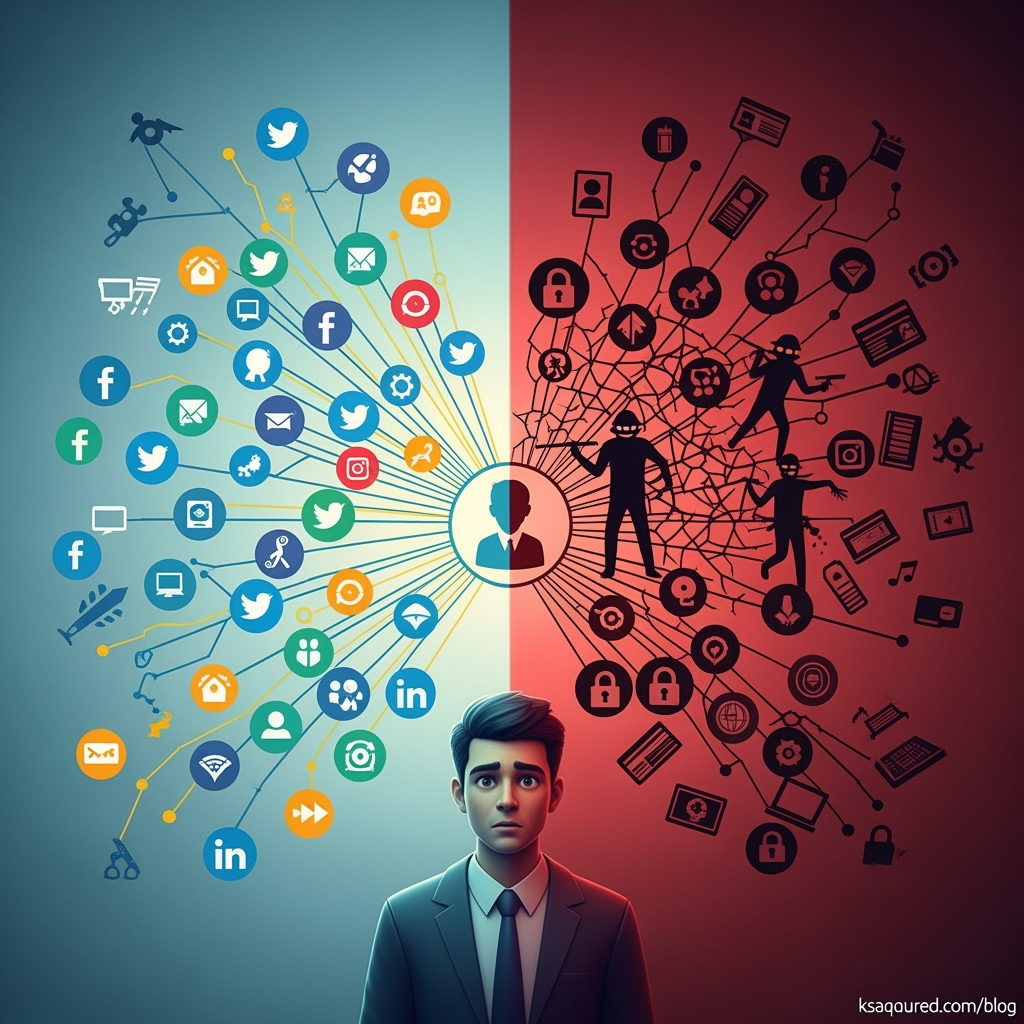Imagine social media as a thrilling high-wire act: one side dazzles with connections, viral moments, and endless scrolls; the other teeters on the edge of privacy pitfalls and cyber chaos. For you and your organisation, it’s not just about likes and shares—it’s a potential gateway for hackers, scammers, and data disasters.
In this post, we’ll swing through the impacts on personal and organisational security, blending fun analogies with real-world tips. Whether you’re a casual scroller dodging DM traps or a CISO fortifying your company’s fortress, let’s make sense of the tightrope—and how to walk it safely.
The Allure and the Abyss: Why Social Media is a Hacker’s Playground
Social platforms like Instagram, LinkedIn, Twitter (X), and TikTok aren’t just apps—they’re digital diaries, networking hubs, and marketing machines. But here’s the catch: they’re also treasure troves of “open-source intelligence” (OSINT) for bad actors. Think of it as leaving your front door unlocked in a bustling city; anyone can peek in.
- For Individuals: Oversharing turns you into a target. That vacation pic with geotags? It screams, “house empty—come rob me.” Fake friend requests or “urgent” messages? Classic phishing bait.
- For Organisations: Employee posts can leak company secrets—like a dev sharing a screenshot with internal code or an exec revealing travel plans for spear-phishing.
Catchy stat: Over 80% of data breaches involve social engineering (Verizon DBIR 2024), and social media fuels 1 in 3 phishing attacks. It’s not paranoia; it’s the new normal in our hyper-connected world.
Personal Security: Your Feed Could Be Feeding the Wolves
Picture your profile as a puzzle—each post, like, or connection adds a piece that hackers assemble into a full picture of you. The impacts? Identity theft, financial scams, or even physical risks.

Everyday Traps and How They Bite
- Phishing in Plain Sight: That “win a free iPhone” post or DM from a “bank”? It’s often malware in disguise, stealing your login credentials.
- Deepfakes and Impersonation: AI-generated videos of “you” saying things you didn’t, tricking friends into sending money.
- Data Harvesting Apps: Those fun “what’s your spirit animal?” quizzes? They slurp up your friends list, emails, and more for targeted attacks.
- Doxxing and Harassment: Public rants or debates can escalate to real-world threats, exposing addresses or routines.
Fun fact for beginners: If you’ve ever clicked “allow” on a third-party app, you might’ve handed over your entire contact list without realising it.
Your Personal Shield:7 Fun, Easy Defences
- Go Incognito Mode: Set profiles to private, limit tags, and think twice before posting live locations.
- Fortify Your Gates: Enable two-factor authentication (2FA)—apps like Google Authenticator beat SMS every time.
- Password Power-Up: Use a manager like LastPass for unique, strong passwords. No more “password123” repeats!
- Sceptic’s Lens: Verify unsolicited messages—call the sender on a known number before clicking anything.
- App Audit Party: Review and revoke permissions from old apps in your settings. It’s like decluttering your digital closet.
- Deepfake Detector: If something feels off (weird audio/video), cross-check with trusted sources.
- Recovery Ready: Add a secure backup email and remove public phone numbers to thwart account hijacks.
Pro tip for techies: Integrate tools like Have I Been Pwned to check for leaked data, and use browser extensions like uBlock Origin to block trackers.
Organisational Security: When One Post Can Topple an Empire
For businesses, social media is a megaphone for branding—but also a bullhorn for breaches. A single employee’s slip can cascade into reputational damage, financial loss, or regulatory fines.
The Corporate Nightmares
- Brand Hijacking: Fake accounts mimicking your company to scam customers (e.g., “official support” phishing for logins).
- Insider Leaks: Posts revealing office layouts, software versions, or client names—gold for targeted attacks.
- Employee Targeting: Hackers befriend staff on LinkedIn, then exploit for ransomware or espionage.
- Ad and Influencer Risks: Malicious ads or rogue partners exposing your audience to malware.
- Crisis Amplification: Viral misinformation or coordinated trolls eroding trust overnight.
Eye-opening example: In 2024, a major brand lost $4 million to a deepfake video of their CEO “announcing” a fake promo, per FBI reports.
Building a Bulletproof Strategy: Layers That Work
Think of it as a security onion—peel back risks with these layers:
- People Power: Roll out engaging training (gamified simulations on phishing) and a clear policy: “Post smart, not sorry.”
- Tech Defences: Use single sign-on (SSO) for official accounts, enforce hardware-based MFA, and deploy social monitoring tools like Brandwatch.
- Process Wins: Create approval chains for posts, automate offboarding to yank access from ex-employees, and run regular audits.
- Incident Playbook: Spot a fake account? Report for takedown, notify users, and analyse for lessons learned.
- Third-Party Vigilance: Vet agencies and tools with security reviews—ensure they follow GDPR/CCPA standards.
Metric magic: Track “phish click rates” in drills—aim for under 5% to show your team’s sharpening up.
The Bright Side: Turning Risks into Wins
Social media isn’t all doom—it’s a force for good when secured. Secure sharing builds communities, boosts brands, and even crowdsources threat intel (like Twitter’s cybersecurity chats). The key? Balance visibility with vigilance.
Wrapping the Wire: Step Off Safely
Walking social media’s tightrope means enjoying the view without the fall. For you personally, it’s about mindful sharing; for organisations, it’s proactive protection. Start small—audit your profiles today—and watch your security soar. What’s your wildest social media security story? Drop it in the comments, and let’s keep the conversation going!
Stay connected, stay secure. Subscribe to Ksqaured for more tech-savvy insights.
Sources: Verizon DBIR 2024, FBI Internet Crime Report, CrowdStrike Global Threat Report.


Leave a Reply